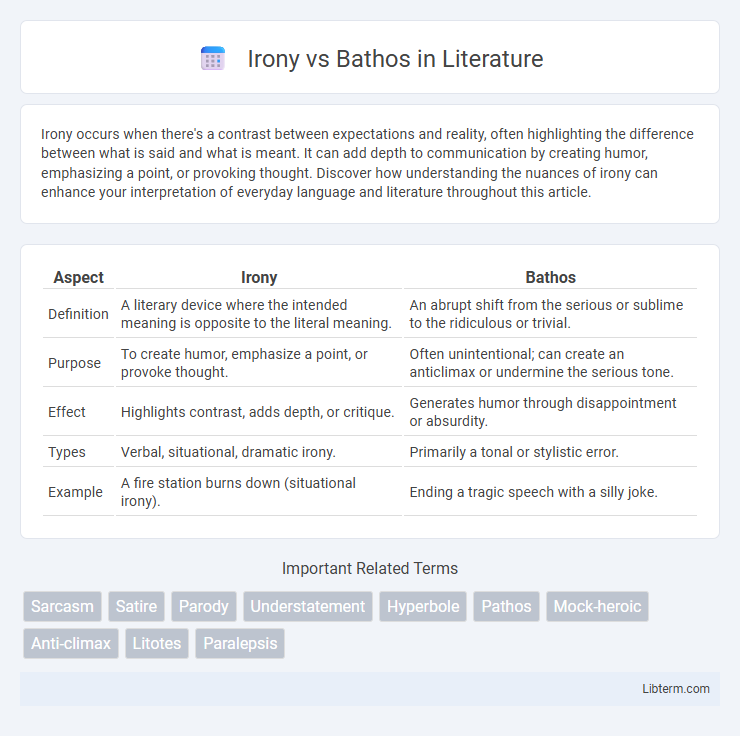Irony occurs when there's a contrast between expectations and reality, often highlighting the difference between what is said and what is meant. It can add depth to communication by creating humor, emphasizing a point, or provoking thought. Discover how understanding the nuances of irony can enhance your interpretation of everyday language and literature throughout this article.
Table of Comparison
| Aspect | Irony | Bathos |
|---|---|---|
| Definition | A literary device where the intended meaning is opposite to the literal meaning. | An abrupt shift from the serious or sublime to the ridiculous or trivial. |
| Purpose | To create humor, emphasize a point, or provoke thought. | Often unintentional; can create an anticlimax or undermine the serious tone. |
| Effect | Highlights contrast, adds depth, or critique. | Generates humor through disappointment or absurdity. |
| Types | Verbal, situational, dramatic irony. | Primarily a tonal or stylistic error. |
| Example | A fire station burns down (situational irony). | Ending a tragic speech with a silly joke. |
Understanding Irony: Definition and Types
Irony is a rhetorical device where the intended meaning contrasts with the literal meaning, creating a layer of complexity or humor. Key types include verbal irony, where spoken words convey the opposite of their literal sense; situational irony, which arises when events defy logical expectations; and dramatic irony, occurring when the audience knows critical information unknown to characters. Mastery of these forms enhances literary analysis and critical thinking.
What is Bathos? Origins and Meaning
Bathos is a literary term originating from the Greek word "bathys," meaning "deep," referring to an abrupt shift from a lofty or serious tone to the trivial or ludicrous, creating an unintentionally humorous effect. Coined by Alexander Pope in his 1727 essay on satire, Bathos describes failed attempts at pathos where exaggerated emotions fall flat and provoke comedy rather than sympathy. This element contrasts with irony, as Bathos results from a drop in tone rather than the contrast between expectation and reality.
Irony vs Bathos: Key Differences
Irony involves expressing a meaning opposite to the literal one, often to create humor or emphasize a point, while bathos refers to an abrupt shift from a serious or elevated tone to something trivial or absurd, resulting in a comedic effect. Irony relies on subtlety and contrast between expectation and reality, whereas bathos depends on an exaggerated descent in style or subject matter. Understanding the distinction helps writers and critics recognize intentional wit versus unintentional anticlimax in literary and rhetorical contexts.
The Role of Irony in Literature and Media
Irony serves as a powerful literary and media device to create deeper meanings by highlighting contradictions between appearance and reality, often provoking critical thinking or humor. Its strategic use engages audiences by fostering layered interpretations, contrasting sharply with bathos, which unintentionally shifts from the sublime to the trivial. Understanding irony's role enhances appreciation of narrative complexity and the emotional or intellectual nuances conveyed in storytelling.
How Bathos Impacts Tone and Style
Bathos significantly impacts tone and style by shifting a text from a serious or elevated mood to a trivial or ludicrous one, often creating an unintended comic effect. This sudden drop can undermine the intended emotional weight, making the work feel overly sentimental or absurdly anticlimactic. Unlike irony, which relies on subtle contrast between expectation and reality, bathos overtly disrupts tonal consistency, affecting the reader's engagement and perception of authenticity.
Common Examples of Irony in Popular Culture
Irony frequently appears in popular culture through situations where characters experience outcomes opposite to their intentions, such as in "The Simpsons," where Homer's well-meaning actions often lead to unintended chaos. Another common example is in the TV show "Friends," where Ross's repeated unsuccessful relationships highlight situational irony, contrasting his desire for love with ongoing romantic failures. Satirical films like "Dr. Strangelove" exploit verbal irony to underscore the absurdity of nuclear war, using witty dialogues that convey meanings opposite to their literal interpretations.
Bathos in Writing: When Emotion Misses the Mark
Bathos in writing occurs when an attempt to evoke deep emotion or grandeur abruptly deflates into triviality or absurdity, undermining the intended impact. Unlike irony, which relies on a contrast between expectation and reality to create subtle or humorous effects, bathos results from a poorly executed shift that feels forced or insincere. This emotional misfire can disrupt reader engagement and weaken the narrative's persuasive power.
Effects of Irony and Bathos on Audience Perception
Irony creates a complex effect on audience perception by engaging critical thinking and eliciting amusement through unexpected contrasts between expectation and reality. Bathos, by contrast, often generates a sense of anticlimax or unintended humor by descending from the serious to the trivial, which can undermine the emotional impact intended by the text. While irony sharpens audience awareness and invites reflection, bathos may cause confusion or disengagement by disrupting the narrative tone.
Avoiding Unintentional Bathos in Creative Writing
Irony in creative writing involves a sharp contrast between expectations and reality, often delivering a witty or poignant effect, while bathos occurs when an attempt at seriousness unintentionally lapses into triviality or absurdity. To avoid unintentional bathos, writers should carefully control tone and maintain consistency in mood, ensuring that emotional shifts feel deliberate rather than jarring or forced. Focusing on precision in language and context helps preserve the intended impact of irony without descending into unintended humor or sentimentality.
Mastering Irony and Bathos: Tips for Writers
Mastering irony and bathos requires understanding their distinct emotional effects; irony delivers subtle, often sharp contrast between expectations and reality, while bathos invokes an abrupt shift from the serious to the ridiculous. Writers should carefully balance tone and context, using irony to engage readers intellectually and bathos to create humor or highlight absurdity without undermining the overall narrative. Effective use involves precise language, controlled pacing, and awareness of the audience's perception to maintain clarity and impact.
Irony Infographic

 libterm.com
libterm.com